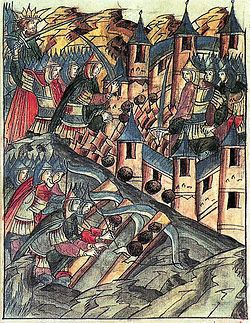Period March 1238 – May 1238 | no data no data | |
 | ||
the entire population of the city on the last day of the siege4000 Similar Mongol invasion of Rus', Battle of the Sit River, Siege of Ryazan, Battle of the Kalka River, Siege of Kiev | ||
Defense of Kozelsk is one of the main events of the Western (Kipchak) March of the Mongols (1236–1242) and the Mongol invasion of Rus ' (1237–1240) at the end of the Mongol campaign in North-Eastern Russia (1237–1238). The siege in the spring of 1238 the town of Kozelsk, one of the specific princely centers of the Chernigov Principality in the former land of the Vyatichi.
Contents
Background
Taking the city of Torzhok on 5 March after a two-week siege, the Mongols went on Seliger's road to Novgorod, however, not reaching about 100 miles, about Ignach cross turned South in the Polovtsian steppe, divided into two groups and continued on the way to destroy the survivors of the city.
Some of the forces led by Kadan and Storms passed over the Eastern route through the Ryazan land. The main forces led by Batu Khan passed through Dolgomost 30 km East of Smolensk, then entered the Chernigov Principality on the upper Gums, burned Vshchizh, but then abruptly turned to the North-East, bypassing the Bryansk and Karachev, at the end of March 1238 went to the Kozelsk on the river Zhizdra.
At that time the city was the capital of the Principality at the head of twelve-year-old Prince Vasily, grandson of Mstislav Svyatoslavich of Chernigov, who was killed at the battle of Kalka in 1223. The city was well fortified: surrounded by ramparts built on them walls, but the Mongols had a powerful siege equipment. Coming in April thaw made it impossible to help of Mikhail Vsevolodovich of Chernigov, the capital of one of its subordinate Autonomous principalities.
Defense
Approaching the city, the troops of the Mongols demanded his surrender. Residents of Kozelsk was decided at the meeting: "Our Prince baby, but we, as true believers, should die to the world to leave a good fame, and behind the coffin to receive the crown of immortality", "the head of his own soul is positive for the Christian faith". Began a seven-week siege.
Arab historian Rashid-ad-DIN, telling about a long siege of Kozelsk, said that the city was taken three days only when the 2 months came troops Kadan and Storms.
With the help of battering machines-vices to the Mongols managed to destroy part of the walls and climb the rampart, where "there was a great struggle and battle evil." Broke a bloody fight, "Kathlene the knives of resouce with them" (apparently meaning mentioned in "Word about Igor's regiment" the so-called seaponies knives). Apparently, the besieged were able to repel the attack, because immediately following this, a decision was made to sortie. Kozelshina managed to destroy the siege machines of the Mongols and 4000 (including three sons Temnikov), but the participants of the outing were killed (during construction in the late nineteenth century railroads in the Tula builders discovered the burial chamber of 267 skulls[2], which roughly corresponds to the assessment of the academician Rybakov B. A. Russian population of the princely castle at the time). Deprived of its defenders, the city fell. The conquerors did not spare anybody, including infants, "trochet sucking the blood". Juvenile Prince Vasili, under the same chronicle to legend drowned in blood: "o princes Vasily and continues CoE: inii Glagolev, thou in the blood of the USBC, poni Bo young be". The monstrous implications of North-Eastern Russia the RAID was over.
Historical significance
Batu was furious unheard of resistance cotelcam. He banned to name the town of Kozelsk, and commanded to call him "Evil castle". Kozelsk took 7 weeks, second in duration only resistance to Kiev. Third place goes to Torzhok, and the rest of the city, including large (Ryazan, Vladimir, and Galich), resisted no more than 6 days. Five months of the winter campaign in 1237/38, against Russia two months Baty spent on Kozelsk.
The reasons long siege
The duration of the siege, according to various versions, could be affected by several factors in different combinations:
In any case, the unparalleled durability of cotelco, recorded in the Chronicles — is the basis of their heroic deeds, preserved in the memory of generations.
